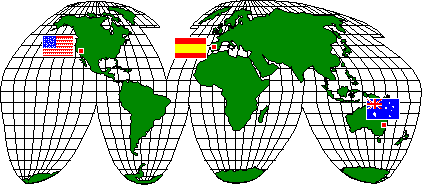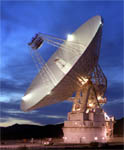
TKK | Tietoverkkolaboratorio | Opetus
The Deep Space Network (DSN), the world's largest, most sensitive spacecraft communications network, provides the vital two-way communications link that both guides and controls the spacecraft and receives telemetry. It should be noticed that the DSN is not primarily a measurement instrument; it is a communication network. The DNS has been vital part of many recent NASA's unmanned space missions, such as Mars Surveyor 98, and Cassini. [1]
The history of the DNS is as long as the US space program. The forerunner of the DNS was used to handle communication with the Exploder 1, in January 1958. The Exploder 1 was the first successful US satellite. During that time, NASA did not exist, and the US space program was a Military operation. Shortly after NASA's establishment in October 1958, the concept of the DNS was introduced. The idea of the DNS was that having a separately managed and operated communications facility avoids the need for each flight project to acquire and operate its own specialized space communications network. [1]
In the following short introduction, the basics of the some issues in the interplanetary communication are covered. The topics covered are not unfamiliar to the peoples in the field of telecommunications. However, the greater distances and the constraints of the spacecraft require those to be considered from a little different view. The issues are:
Signal power a spacecraft can generate is limited due to its small power source. Typically, the signal power it is less than 20 W. Therefore, microwave frequencies are used, and all available power is concentrated into a narrow beam. The beam is sent in one direction instead of broadcasting in all directions. This is typically done using a parabolic dish antenna on the order of 1 or 5 meters in diameter. Even when these concentrated signals reach Earth, they have vanishingly small power. The rest of the solution is provided by the DSN's large aperture reflectors, cryogenically-cooled low-noise amplifiers and sophisticated receivers, as well as data coding and error-correction schemes.
Uplink and Downlink refer to the direction of the transmission. The Uplink is the transmission from Earth to the spacecraft, and the transmission from the spacecraft to Earth is downlink. The communication between Earth and the spacecraft may be one-way (i.e. only downlink) or two-way. The data transferred is called telemetry data and command data, respectively
Information is transferred on a carrier by shifting each waveform's phase slightly at a given rate. Modulation scheme used in the interstellar communication is frequency modulation (FM). In the FM, the carrier is modulated with a frequency, for example near 1 MHz. This 1 MHz modulation is called a subcarrier. The subcarrier is in turn modulated to carry individual phase shifts which are designated to represent groups of binary 1s and 0s-the spacecraft's telemetry data. The amount of phase shift used in modulating data onto the subcarrier is referred to as the modulation index, and is measured in degrees. The same kind of scheme is also used on the uplink.
Demodulation is the reverse operation of the modulation. The subcarrier is detected from the carrier and processed separately. From the subcarrier, the individual binary phase shifts are detected and decoded into digital data for further processing.
Not every instrument and sensor aboard a spacecraft can transmit its data at the same time, so the data are multiplexed. In the time-division multiplexing (TDM) scheme, the spacecraft's computer samples one measurement at a time and transmits it. On Earth, the samples are demultiplexed, that is, assigned back to the measurements which they represent. In order to maintain synchronization between multiplexing and demultiplexing (also called mux and demux) the spacecraft introduces a known binary number many digits long, called the pseudo-noise (PN) code at the beginning of every round of sampling (telemetry frame), which can be searched for by the ground data system. Once recognized, it is used as a starting point, and the measurements can be demuxed since the order of muxing is known.
Newer spacecraft use packetizing rather than TDM. In the packetizing scheme, a burst or packet of data is transmitted from one instrument or sensor, followed by a packet from another, and so on, in non-specific order. Each burst carries an identification of the measurement it represents for the ground data system to recognize it and handle it properly. These schemes generally adhere to the International Standards Organization (ISO)'s Open Systems Interconnection (OSI) protocol suite, which recommends how computers of various makes and models can inter-communicate. The ISO OSI is distance independent, and holds for spacecraft light-hours away as well as between workstations.
Aside from the information modulated on the downlink as telemetry, the carrier itself is used for tracking the spacecraft, and for carrying out some types of science experiments. For each of these uses, an extremely stable downlink frequency is required, so that Doppler shifts on the order of fractions of a Hertz may be detected out of many GHz over periods of hours. To achieve this, the spacecraft generates a downlink, which is phase-coherent to the uplink it receives. The uplink uses a standard frequency based on a hydrogen-maser. In addition, non-coherent downlink is used by most satellites. It can be used only for the telemetry data, not for tracking. [2]
The DSN currently consists of three deep-space communications facilities placed approximately 120 degrees apart around the world: at Goldstone, in California's Mojave Desert; near Madrid, Spain; and near Canberra, Australia (Figure 1). This placement of the facilities allows continuos communication with the spacecraft as Earth rotates. The coverage areas of the ground stations also overlap to facilitate radio link transfer from one station to the another.

Figure 1: DNS communications facilities [1]
Each complex consists of at least four deep space stations equipped with ultrasensitive receiving systems and large parabolic dish antennas. There are:

Figure 2: 70-m Antenna at Goldstone [1]
Several of the antennas may be arrayed to form a one even larger antenna. This improves the sensitivity of the antennas and thus weaker signals can be received. The need for better signal retrieval rise unexpectedly when the Galileo failed to open its main antenna. The arraying of the antennas was developed as a solution to Galileo's communication problems.
The communications facilities only send and receive the data. Telemetry data received from the spacecraft is relayed from a telecommunications facility to the network communications control facility (NCCO) at Jet Propulsion Laboratory (JPL) for processing and further delivery to a mission control. Similarly, the command data to the spacecraft is generated at the mission control and sent to the JPL for delivery. The JPL then delivers the data to a communications facility, which sent it to the spacecraft.
The communication between the NCCO and the three communication facilities uses WAN circuits to each complex. These circuits contains one satellite hop and have capabilities from 768 kb/s to 1.5Mb/s. The protocol used is either TCP/IP or X.25. [1][2][3][4]
The communication from the communication facility to a spacecraft has two separate forms, namely command data and telemetry data. The command data transfer is discussed first, and then the telemetry data transfer is addressed.
The command data is sent using positive acknowledgements with sliding window. The spacecraft acknowledges an accepted command using a frame number, and the acknowledgement is appended to the next available telemetry frame. The complicating factor of the system is the fact that commands are sent from mission controls to NCCO for delivery, which then transmits the commands to the spacecraft via communications facilities. The NCCO and its components are responsible for data delivery. Consequently, the NCCO must be informed of failed command delivery, and the NCCO decides if retransmission should be done. This scheme of introduces delays that must be considered when the command communication with a spacecraft is designed.
The DSN does not provide any error detection or correction facilities. Thus, each mission must use its own error correction/detection scheme. The mission controls may request command validation. When the validation is active, the NCCO informs the mission control of the status of the command (accepted/retransmitted).
No error detection is done for the telemetry data. It may be operated by the DNS to varying degrees or just delivered on its raw form to the particular mission for processing. The maximum transmission speeds for telemetry data are around 2Mb/s. [4]
The DSN network offers the following functions: [1]
[1] Wolff S, Deep Space Network, NASA, URL: http://ds1.jpl.nasa.gov/dsn/index.html
[2] Doody D., Stephan G., Basics of Space Flight Learners' workbook, Jet Propulsion Laboratory, California Institute of Technology, December 1995
[3] Warren M., AMMOS and DSN Support of Earth Orbiting and Deep Space Missions, Jet Propulsion Laboratory, California Institute of Technology, October 1996
[4] Renzetti N. (editor), The Evolution of technology in the Deep Space Network - A history of the Advanced Systems Program, Jet Propulsion Laboratory, California Institute of Technology, 1995
Tietoverkkolaboratorio on nyt osa Tietoliikenne- ja tietoverkkotekniikan laitosta. Tällä sivulla oleva tieto voi olla vanhentunutta.
Kurssien ajantasainen tieto on MyCourses-palvelussa.
|
Tämä sivu on tehty oppilaiden harjoitustyönä. Tietoverkkolaboratorio ei
vastaa sivun oikeellisuudesta, ajantasaisuudesta tai ylläpidosta.
Vakavissa tapauksissa yhteyshenkilöinä toimivat ja
Webmaster.
Sivua on viimeksi päivitetty 11.11.1999 20:59. URI: http://www.netlab.tkk.fi/opetus/s38118/s99/htyo/3/2.shtml [ TKK > Sähkö- ja tietoliikennetekniikan osasto > Tietoverkkolaboratorio > Opetus ] |